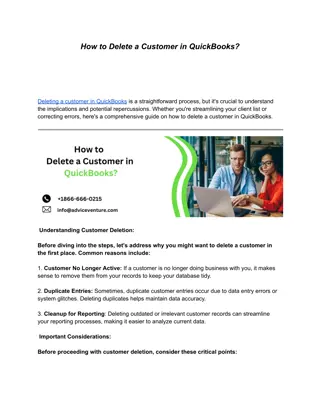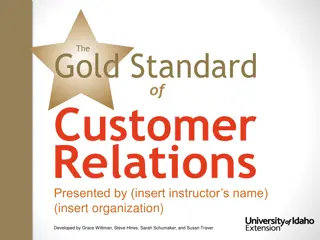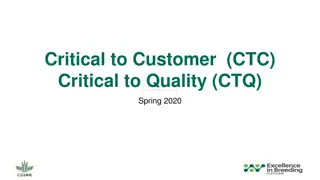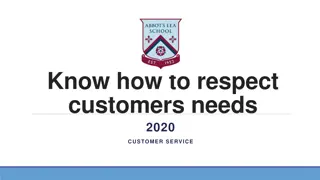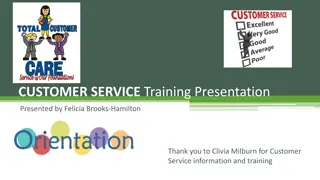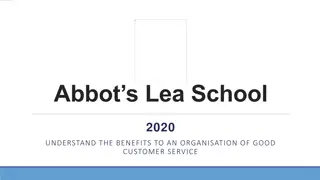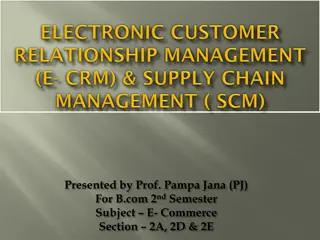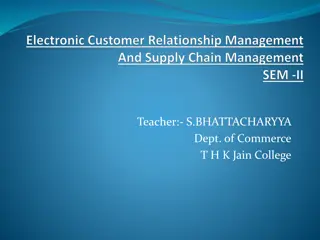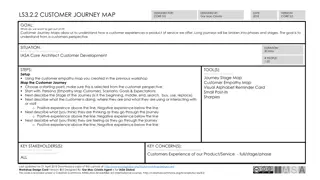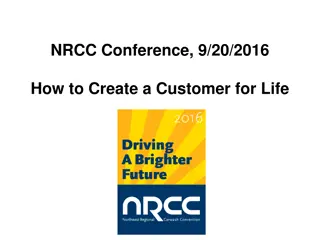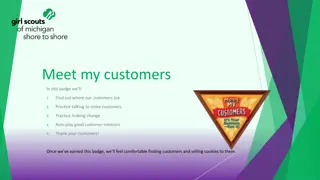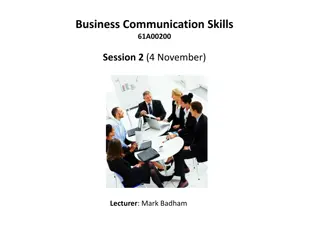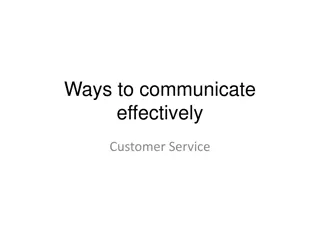Customer Service Skills: Essential Practices for Effective Communication
Developing customer service skills is crucial for professionals in all industries. From active listening to clear communication, these skills can enhance customer satisfaction and loyalty. Patience, clear communication, and positive language are key components in handling customers effectively and ensuring their needs are met with empathy and professionalism.
Download Presentation

Please find below an Image/Link to download the presentation.
The content on the website is provided AS IS for your information and personal use only. It may not be sold, licensed, or shared on other websites without obtaining consent from the author. Download presentation by click this link. If you encounter any issues during the download, it is possible that the publisher has removed the file from their server.
E N D
Presentation Transcript
Soft Skills David Scott, CBET
Started as a student in Biomed in 1989 Started Colorado Association of Biomedical Equipment Technicians (CABMET) CBET Study Group in 2004 2009 AAMI/GE Biomed of the Year Member of 2012 MD Publishing Department of the Year Featured as Tech of the Month in Medical Dealer Magazine Served as CABMET President, Vice President, Board Member Provided CBET Review at MD Expo AAMI CBET Review Presenter A.S. Degree in Sports Medicine Technology Military trained BMET (US Army) Employed as a Senior Biomedical Technician at UCHealth A little about me
Customer Service HEAT AIDET Work Order Management Professional Emails Professionalism Topics Covered
Customer service skills are often described as things like being a people person Being a people person isn t a skill it s a trait it s not something you can develop. Here s a list of skills not traits that are both developable and observable. Customer Service
Customers who reach out to Biomed are often confused and frustrated. Being listened to and handled with patience goes a long way in helping customers feel like you re going to alleviate their current frustrations. Patience Patience among customer service teams is also important because great service beats fast service every single time. If you deal with customers on a daily basis, be sure to stay patient when they come to you stumped and frustrated, but also be sure to take the time to truly figure out what they truly need.
Be mindful of how some of your communication habits translate to customers, it s best to err on the side of caution whenever you find yourself questioning a situation. You need to be cautious about how communication habits translate to customers. Communicate Clearly When it comes to important points that you need to relay clearly to customers, keep it simple and leave nothing to doubt. For example, once I went to get work done on my car, I was told by an employee that if I wanted an oil change, it would be included in my final bill. I thought that meant I d be getting it for free, yet as it turns out, that wasn t the case.
Customer service means having the ability to make minor changes in your conversational patterns. This can truly go a long way in creating happy customers. For example, let s say a customer contacts you with a service call- that s not an emergency. Using positive language Responding with positive language can affect how the customer hears your response: Without positive language: I m really busy right now and I m not sure when I can get to your call With positive language: Your call is important to me. I m working on a couple things right now and I will be there as soon as I can
Sometimes youre going to come across people who you ll never be able to make happy. Situations outside of your control (they had a terrible day, or they are just a natural-born complainer) will sometimes creep into your usual support routine. Acting skills You ll be greeted with those barnacle customers that seem to want nothing else but to pull you down. A great customer service professional needs basic acting skills to maintain their usual cheery persona in spite of dealing with people who are just plain grumpy.
This person is sometimes described as: keeps their cool, staying cool under pressure, and so on, but it all represents the same thing: The ability to stay calm and even influence others when things get crazy ! Sometimes we are put in stressful situations and other people (doctors, nurses, other techs) are aggravated because their equipment is not working as it should. Unflappability BMETs need to be the calming factor. That way the customers know we have it under control. The best BMETs know that they can t let a situation force them to lose their cool. In fact, it is our job to try to be the rock for customers who think the world is falling apart as a result of their current problems.
You want to create a system for when you come across a customer who has a product or service problem you ve never seen before. You need to know: Who? Decide who should be your go-to person when you don t know what to do. Define a logical escalation path so you won t be left wondering who you should reach out to. Maybe when to call tech support or a co- worker? What? When the problem is out of your league, what are you going do? Get help from a co-worker, call in manufacturer/factory support? Tech support? How? When it comes time to get someone else involved, how are you going to contact them? At what point do you draw the line and realize you need help? Ability to handle surprises
A willingness to do what needs to be done (and not take shortcuts) is a key skill when providing the kind of service that people talk about. Tenacity Remembering your customers are people too and knowing that putting in the extra effort will come back to you ten-fold should be your driving motivation to never cheat your customers with bad service.
H.E.A.T. Hear them out Empathize Apologize Take Action
This isnt always easy to do, but in the end the customer is going to feel better. H Hear them out If they can just get it off their chest, it s likely they ll be much more open to your solutions. We ve all been there; sometimes a person just needs to vent. Let them talk, and simply listen.
Feel what your customer is feeling by putting yourself in their shoes. Empathize Name their emotions: I understand that you are frustrated. I would be too. By showing your customer you understand, you can begin to defuse the situation.
This one is important, especially if you did not personally make the error or create the situation that s making the customer angry. Apologize Maybe you didn t do it, but Biomed did and you re a team. A simple I m sorry can go a long way. Stand united, take the HEAT for your team. We all make mistakes.
Make sure you have an action plan ready to follow your apology. Take Action How are you going to fix the problem? What can the customer expect next? It will probably sound something like, I m so sorry that this has happened. Here s what I can do .
Greet people with a smile and use their names if you know them. Attitude is everything. Create a lasting impression. Acknowledge
Introduce yourself to others politely. Tell them who you are and how you are going to help them. Introduce
Give the best estimate of how long you think what you are doing will take to complete Duration
Advise others what you are doing, how procedures work. Explanation
Thank somebody. Thank people for their help or assistance. Thank You
Example w/ Staff: Hi, I m Dave with the Clinical Engineering Department. I will be working in your department today to complete maintenance on medical equipment. I will be here most of the morning. Thanks at the end of your work. AIDET
Example with Patient or Patient Family: Hi, I m Dave from the Clinical Engineering Department. I m here to look at the monitor in your room. This should only take a few minutes. (After work is done) Thank you for your time. AIDET
Work Order Measurement Metrics What will management be looking at from you?
What is looked at in Fantasy Football? Statistics Average points per game Projected points- guess by experts what they think Who can get your team the most points? Getting the best players That s how the starting line up is made These factors make up the strength of your team Fantasy Football Reference
PM Completion Percentage Time Management Average Repair Time Total Time to Repair Cost of repairs- labor and parts Work Order Analysis HTM Measurement Metrics
How many of your PMs you get done in the period they are assigned Factors- Cannot locate In use Salvaged Storage PM Completion Percentage
This tells management what you are doing throughout your day Time to complete PMs Time to complete repairs Time for meetings Time for professional development Time for whatever else you do during the day Usually, management will be looking at how many hours out of a day you have booked or accounted for. You might have a department goal? Usually, management will want you to account for most of your 8-hour day on workorders Time Management
PMs Divide up time for PMs completed Some PMs take longer to do than others Does your workplace have standard times for PMs? If so use them Time for ordering PM parts Time for looking for PMs that are due even though they weren t completed. If PM is done by vendor count the time to set up the call with vendor, PO, Schedule with the user and FSE. Time to meet the vendor and show them to the equipment. Time to get the PM report from vendor and post it and complete PM Time Management
This is an area where a lot of techs get in trouble!!! If everyone is doing this correctly it can make management s job easier This can help factor into adding staffing Look at solutions to time consuming tasks and look for solutions Time Management
Gives management an idea of how much time is being spent on repairs on average. Depending on the area techs work average repair times can vary Sometimes used to compare repair times among techs Used to determine techs needed to complete the workloads and department staffing Average Repair Time or Average Work Order Time
This is usually measured in days time to complete Gives management an idea of how long it takes to turn over repairs Can factor into department staffing levels Can also point out areas that need more investigation Such as parts availability or backorders for parts Time it s taking a vendor to complete work sent to them Measurement of department efficiency Total Time to Repair
Cost of Service Ratio (COSR) Purchase cost of equipment inventory Factors: Shop hourly labor rate Cost of parts Cost of vendor repairs Cost of service expenses- such as mileage reimbursement or transportation cost Cost of service contracts Operational Costs- example: office supplies, printer paper, etc. All of these factor into a ratio (COSR) Measured in a percentage Cost of Repairs
Cost of repairs can help identify equipment with high repair costs Can look at history of the equipment and how much has been spent to repair it over its lifetime. Once the equipment reaches a threshold it can be added to a list of equipment needing to be replaced with new equipment. Can help identify lemons Helps equipment planning Cost of Repairs
Cost of Repairs COSR Cost of Service Ratio is a measurement of department efficiency COSR can help in looking at areas to cut costs and service contracts Your medical equipment requires PM labor, PM parts, repairs, some user errors, service calls, maybe a service contract.
PM work orders are analyzed to determine whether an AEM can be done AEM is Alternate Equipment Maintenance This maintenance differs from the manufacture recommended interval or PM steps. If PMs are routinely completed on a certain piece of equipment with no adjustments necessary, then maybe an AEM can be considered. Equipment with no previous service history are not eligible for AEMs Analysis
It is important to code PM work orders correctly. If a PM passes with no adjustments the work order should be closed noting no adjustments needed. If minor adjustments are needed, then close it that way. If repairs are needed at PM close with completed- repairs needed and open a corrective maintenance work order. All these closing codes play into the AEM determination. Analysis
Subject Line Always fill in the subject line with a topic that means something to your reader. Make it pertinent to what the email is about Such as Treadmill Repair in PT Gym Or just Treadmill Repair Professional Emails
Put your main point in the opening sentence. Most readers won't stick around for a surprise ending. Make your email as short as possible. Be considerate of others time. Be brief and polite. If your message runs longer than two or three sentences, consider (a) reducing the message or (b) providing an attachment. Take all emotion out of the email. Just state facts. Don't use ALL CAPITALS (no shouting!), or all lowercase letters either. Professional Email
As a general rule, PLZ avoid textspeak (abbreviations and acronyms): You may be ROFLOL (rolling on the floor laughing out loud), but your reader may be left wondering WUWT (what's up with that)! Professional Email No slang It is a professional email sent in a business setting. This is not a text
Appropriate Closing The end before putting your name. Don t get too creative. Some endings are considered distracting sign-offs such as cheers and VR (very respectfully), so choose one that won t feel out of place. Some of the most reliable options are: Sincerely, Yours truly, Thanks again, Appreciatively, Best regards, Respectfully, Professional Email
Add a signature block with appropriate contact information. It should include: your name, business address, and phone number. A legal disclaimer (if required by your company). Do not clutter the signature block with a clever quotation and artwork. Your workplace might have a format for accepted signature blocks Professional Email
Edit and proofread before hitting "send." You are not too busy to sweat the small stuff. Take the time to complete this step. If this is not done your reader may think you re careless or do not pay attention to details. Professional Email
Reply promptly to serious messages. If you need more than 24 hours to collect information or make a decision, send a brief response explaining the delay. Professional Email
Out of office reply When you know you re going to be off work set up an auto reply. Include on the auto reply what phone number to call instead of yours- maybe a shop or department number. Or if it can wait until you get back This way the customer will not be expecting a quick response. Professional Email
You are a professional You will be talking with other professionals You could be talking with doctors, nurses, directors, VPs. Dress appropriately You only get one chance to make a first impression Dress for Success
No jeans No sneakers- unless maybe you wear scrubs as a uniform No hats Pants - Dockers style- comfortable Shirt- polo is a minimum, button shirt is better Shoes- casual business shoes- something comfortable What does this mean?



